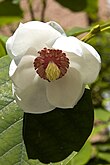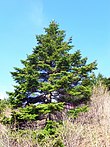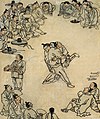National symbols of North Korea
 | |
| Emblem | |
|---|---|
| Anthem | "Aegukka" |
| Song | "Arirang" |
| Language | Korean |
| Currency |
[[File:|frameless|110px|North Korean won]]
|
| Calendar | North Korean calendar |
| Living insignia | |
| Bird | |
| Flower | |
| Tree | |
| Inanimate insignia | |
| Color | |
| Costume | |
| Sport | |
This article may require cleanup to meet Wikipedia's quality standards. The specific problem is: MOS:OVERLINK. (January 2024) |
 |
| Part of a series on the |
| Culture of Korea |
|---|
| Society |
| Arts and literature |
| Other |
| Symbols |
|
Upon its liberation in 1945 and subsequent foundation in 1948, North Korea adopted national symbols distinct from the national symbols of South Korea. The traditional flag of Korea, the Taegukgi, and the symbol Taeguk, were swapped for socialist symbols.
Some of the symbols of North Korea—the national emblem, flag, anthem and capital—are defined in the constitution of North Korea, while others such, as the national sport Ssirum or the national dish kimchi, are traditional. Some traditional symbols are shared with the South but with different connotations. Mount Paektu, for instance, is recognized as the symbol of Korea across the peninsula, but North Koreans revere it as the birthplace of Kim Jong Il. Some North Korean symbols are complemented with symbols for the ruling Kim family. For example, the Magnolia sieboldii is the national flower but the hybrid orchids Kimilsungia and Kimjongilia are also respected.
Constitutionally defined symbols
Chapter VII of the Socialist Constitution of the Democratic People's Republic of Korea defines the emblem, flag, anthem and capital of North Korea, while the head of state is stipulated by article 117 of chapter VI.[1]
National emblem
The national emblem of the Democratic People's Republic of Korea bears the design of a grand hydroelectric power station under Mt. Paektu, the sacred mountain of the revolution, and the beaming light of a five-pointed red star, with ears of rice forming an oval frame, bound with a red ribbon bearing the inscription "The Democratic People's Republic of Korea."
Article 169 of the Socialist Constitution of the Democratic People's Republic of Korea (1972, amended 2013)[1]
The present emblem of North Korea was adopted on 9 September 1948, on the Day of the Foundation of the Republic. It features a hydroelectric plant and the design was,[2] much like the flag,[3] probably commissioned by the Soviets. The design was amended in 1993 to feature, under the red star, Mount Paektu – in itself an important symbol of Korea[2] – which North Korea considers the birthplace of Kim Jong Il. [4]
National flag
The national flag of the Democratic People's Republic of Korea consists of a central red panel, bordered both above and below by a narrow white stripe and a broad blue stripe. The central red panel bears a five-pointed red star within a white circle near the hoist.
The ratio of the width to the length is 1:2.
Article 170 of the Socialist Constitution of the Democratic People's Republic of Korea (1972, amended 2013)[1]
The flag of North Korea was designed in 1948 and adopted the same year to replace Taegukgi, the traditional flag. The Taeguk symbol thus only remained in the flag and emblem of the South.[3] The colors of the North Korean flag – red, white and blue – are considered national colors and symbolize respectively: the sacrifice of the people who fought for independence; purity, honesty, and dignity; and the revolutionary spirit of the Koreans.[5]
National anthem
The national anthem of the Democratic People's Republic of Korea is "The Patriotic Song."
Article 171 of the Socialist Constitution of the Democratic People's Republic of Korea (1972, amended 2013)[1]
The national anthem is "Aegukka" (Korean for 'The patriotic song'), written by Pak Se-yong and composed by Kim Won-gyun in 1946. Musically, it is similar to South Korea's national anthem, spelled "Aegukga".[6] The first stanza of the song aims to show the dignity, pride and love to their country while the second is about the will to have Korea as a powerful, independent nation.[5] The folk song "Arirang" is known as the "unofficial national anthem of Korea".[7] North and South Korea have submitted it separately to UNESCO's Representative List of the Intangible Cultural Heritage of Humanity.[7]
Capital
The capital of the Democratic People's Republic of Korea is Pyongyang.
Article 172 of the Socialist Constitution of the Democratic People's Republic of Korea (1972, amended 2013)[1]
The first 1948 constitution defined Seoul – the present capital of South Korea – as the capital city. In order to have succeeded in realizing this, the South Korean regime would have had to be removed.[8] In 1972 the constitution was revised and Pyongyang designated as the capital.[9]
Head of state
The President of the Presidium of the Supreme People's Assembly represents the State and receives the credentials and letters of recall of diplomatic representatives accredited by foreign countries.
Article 117 of the Socialist Constitution of the Democratic People's Republic of Korea (1972, amended 2013)[1]
The head of state of North Korea has been the President of the Presidium of the Supreme People's Assembly since 1998.[10] The post was held by Kim Yong-nam since its current inception until the 11th of April 2019 when Choe Ryong-hae took the position.
Animals and plants
North Korea has no official national animal, but the mythological winged horse Chollima is taken to be a national symbol.[11] North Korean Siberian tigers are considered unofficial symbol of both Koreas as it represent the Korean people and nation.[12]
The national dog is the Pungsan dog. Pungsan is named after what was once Phungsan County (now Kimhyonggwon County) in Ryanggang Province. It has been bred as a hunting dog. Recently, efforts to conserve and proliferate the breed have been taken.[13]
The national bird is the northern goshawk (Accipiter gentilis).[14] The bird inhabits the northern and central parts of the peninsula and sometimes migrates to the southern part of the country in winter. Historically, Koreans have used the goshawk to hunt pheasants, pigeons and hares[15] and killing a hawk was considered a dishonourable act.[16]
The national flower is the Magnolia sieboldii.[17] Within North Korea, the flower can be found everywhere except for North Hamgyong Province, Ryanggang Province and Chagang Province.[5] Two orchid hybrids are also significant: Kimilsungia and Kimjongilia.[18] They are both considered unofficial national flowers.[19]
The national tree is pine (Pinus densiflora).[20][21][22] Pines are considered beautiful aspects of scenery and have been featured in Korean visual arts since ancient times.[23] Pine trees are considered to be one of the ten symbols associated with longevity.[24] The behaviour of the pine tree in winter is also seen as a symbol of a resolute will.[20] Earlier, Kim Hyong-jik, the father of Kim Il Sung, had composed a poem: "Green Pine on Nam Hill" to promote liberation of the country.[23]
Others

The national day on 9 September is the Day of the Foundation of the Republic, a public holiday that commemorates the date when Kim Il Sung appointed a cabinet in 1948.[25] Both the birthplace of Kim Il-sung at Mangyongdae and the Juche Tower are considered national monuments.[26][27]
The national dish is kimchi, a spicy, fermented vegetable dish.[28] North Korean kimchi tends to be less spicy than its Southern counterpart.[29] Both are inscribed on UNESCO's Representative List of the Intangible Cultural Heritage of Humanity.[30] The national liquor is Pyongyang Soju.[31] The traditional Choson-ot (hanbok) is the national dress.[32] The national sport is Ssirum, traditional Korean wrestling, but the martial art Taekwondo is important, too.[33]
Kim Il Sung, founder and president of the modern North Korean state and his successor Kim Jong Il are considered national heroes if not personifications.[34] The Order of Kim Il Sung and the Order of Kim Jong Il are the highest orders of merit of the country.[35] Cho Ki-chon is considered a national poet.[36]
Mount Paektu is recognized as a symbol of Korea in the North and South alike, but North Korea has attached special significance to it by claiming that it is the birthplace of Kim Jong Il. Tangun, who is considered the founder-king of the Korean nation, is also said to be born at Mount Paektu and is celebrated in North Korea especially. In 1993 North Korean archaeologists located and dated remains in a tomb that they declared Tangun's grave.[4]
See also
- Culture of North Korea
- Cultural assets of North Korea
- National Treasure (North Korea)
- Names of Korea
- Natural monuments of North Korea
- Orders, decorations, and medals of North Korea
- List of things named after Kim Il Sung
References
- ^ a b c d e f Socialist Constitution of the Democratic People's Republic of Korea (PDF). Pyongyang: Foreign Languages Publishing House. 2014. ISBN 978-9946-0-1099-1. Archived from the original (PDF) on 8 June 2016. Amended and supplemented on April 1, Juche 102 (2013), at the Seventh Session of the Twelfth Supreme People's Assembly.
- ^ a b Tertitskiy, Fyodor (23 September 2014). "The Evolution of North Korea's Coat of Arms". Daily NK. Retrieved 30 September 2015.
- ^ a b Tertitskiy, Fyodor (20 June 2014). "Kim Tu Bong and the Flag of Great Extremes". Daily NK. Retrieved 30 September 2015.
- ^ a b Pratt, Keith (2007). Everlasting Flower: A History of Korea. London: Reaktion Books. p. 33. ISBN 978-1-86189-335-2.
- ^ a b c "National Symbols". Naenara.
- ^ Hoare, James E. (13 July 2012). Historical Dictionary of Democratic People's Republic of Korea. Plymouth: Scarecrow Press. p. 273. ISBN 978-0-8108-7987-4.
- ^ a b "N. Korea's Arirang wins UNESCO intangible heritage status". Yonhap. 27 November 2014. Retrieved 25 November 2015.
- ^ Eberstadt 1999, p. 26.
- ^ Eberstadt 1999, p. 32.
- ^ Cha & Hwang 2008, p. 196.
- ^ Foran 2013, p. 132.
- ^ "Horang-i" 호랑이 [Tiger]. Encyclopedia of Korean Culture (in Korean). Retrieved 8 January 2010.
- ^ Kang 2015, p. 27.
- ^ "Protection of Goshawk Active in DPRK". Naenara. Korean Central News Agency. 5 March 2016. Retrieved 6 March 2016.
- ^ "Goshawk, National Bird of Korea". KCNA. 21 April 2014. Retrieved 22 September 2015 – via KCNA Watch.
- ^ Kim 2019, p. 41.
- ^ Lim, Reuben C. J. (29 June 2013). "Floral Emblems of the world". Australian National Herbarium, Australian National Botanic Gardens. Retrieved 9 September 2016.
- ^ Foran 2013, p. 38.
- ^ Minahan 2010, p. 82.
- ^ a b Kim 2019, p. 32.
- ^ "North Korea Newsletter 360 (April 30, 2015)". Yonhap. 30 April 2015. Retrieved 22 September 2015.
- ^ Han Su-yong (2016). Understanding Korea (PDF). Vol. 3: Politics. Pyongyang: Foreign Languages Publishing House. ISBN 978-9946-0-1406-7.
- ^ a b "Pine Tree Symbolic of Spirit of DPRK". KCNA. 24 April 2015. Archived from the original on 7 July 2015. Retrieved 22 September 2015.
- ^ Kim 2019, pp. 32–33.
- ^ Tertitskiy, Fyodor (9 September 2015). "The Soviet strategy behind NK's Foundation Day". Daily NK. Retrieved 30 September 2015.
- ^ Cornell, Erik (2005). North Korea Under Communism: Report of an Envoy to Paradise. Translated by Bradbury, Rodney. London: Routledge. p. 123. ISBN 978-1-135-78822-3.
- ^ Lerner, Mitchell (2008). "Making Sense of the 'Hermit Kingdom': North Korea in the Nuclear Age". Origins. 2 (3). Retrieved 5 October 2015.
- ^ Becker, Jasper (2005). Rogue Regime: Kim Jong Il and the Looming Threat of North Korea: Kim Jong Il and the Looming Threat of North Korea. USA: Oxford University Press. p. 121. ISBN 978-0-19-803810-8.
- ^ North Koreans Want UNESCO Recognition for Their Kimchi Variation. Voice of America. 2 December 2015. Event occurs at 1:10. Retrieved 3 December 2015 – via YouTube.
- ^ "UNESCO Adds N. Korea's Kimchi-Making to Cultural Heritage List". KBS. 3 December 2015. Archived from the original on 14 April 2021. Retrieved 3 December 2015.
- ^ Kim 2019, p. 52.
- ^ French, Paul (2007). North Korea: The Paranoid Peninsula: A Modern History, Second Edition (2 ed.). London / New York: Zed Books. p. 42. ISBN 978-1-84277-905-7.
- ^ Behnke, Alison (2005). North Korea in Pictures. Twenty-First Century Books. p. 117. ISBN 978-0-8225-1908-9.
- ^ Minahan 2010, p. 84.
- ^ "Order of Kim Jong Il Instituted". KCNA. Archived from the original on 12 October 2014. Retrieved 6 June 2012.
- ^ 기획 기사 [9.9절 방북취재-6]<백두산은 역시 혁명의 성산> (in Korean). Korean American National Coordinating Council. 23 September 2008. Retrieved 10 November 2020.
Works cited
- Cha, Victor D.; Hwang, Balbina Y. (2008). "Government and Politics" (PDF). In Worden, Robert L. (ed.). North Korea: A Country Study (Fifth ed.). Washington: Government Printing Office. pp. 181–234. ISBN 978-0-16-088278-4.
- Nick Eberstadt (1999). The End of North Korea. Washington: American Enterprise Institute. ISBN 978-0-8447-4087-4.
- Foran, Racquel (2013). North Korea. Minneapolis: ABDO Publishing Company. ISBN 978-1-61480-875-6.
- Kang Su-jong (2015). "Symbols of Korea" (PDF). Korea Pictorial. No. 4. pp. 26–27. ISSN 1727-9208. Archived from the original (PDF) on 4 March 2016.
- Kim Yong-son, ed. (2019). National Symbols of the DPRK (PDF). Translated by Jong Myong-jin. DPR Korea: Foreign Languages Publishing House. ISBN 978-9946-0-1895-9.
- Minahan, James (2010). The Complete Guide to National Symbols and Emblems. Vol. 1. Satna Barbara: ABC-CLIO. ISBN 978-0-313-34497-8.
Further reading
- Choe Yong-thae (2018). A Grand Birth (PDF). Translated by Kim Myong-chan. Pyongyang: Foreign Languages Publishing House. ISBN 978-9946-0-1724-2.
- Hong Kyong-sik (1992). Magnolia Sieboldii: Korea's National Flower (PDF). Pyongyang: Foreign Languages Publishing House. OCLC 52473426.
- So Yong-il (2010). Ri Sun-yong (ed.). Kimchi: Korean Speciality (PDF). Pyongyang: Foreign Languages Publishing House. ISBN 978-9946-0-0521-8.
- Tangun: Founder-King of Korea: Collection of Treatises (PDF). Translated by An Jong-h; Choe Ki-ju; Ryom Chol-su; O Su-gun; Ryang Sun-chol. Pyongyang: Foreign Languages Publishing House. 1994. OCLC 272459364.






